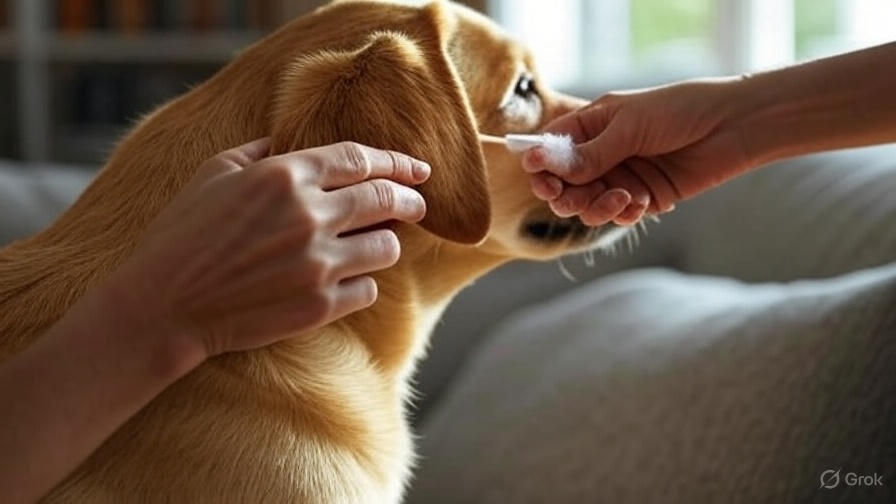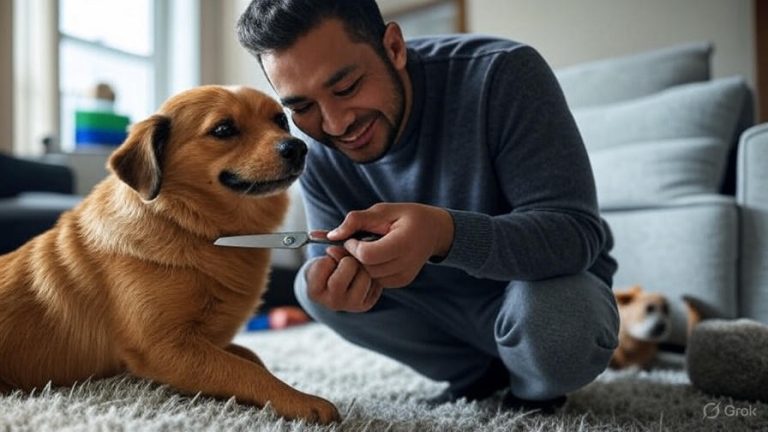How to Treat Dog Ear Infection Without Vet?
Dog ear infections rank among the most common health issues pet owners face. Your furry friend starts scratching relentlessly, shaking their head constantly, and you notice that unmistakable smell coming from their ears. While veterinary care remains the gold standard for serious infections, many mild cases respond well to gentle home treatments when caught early.
This comprehensive guide explores proven home remedies, prevention strategies, and crucial warning signs that indicate when professional veterinary intervention becomes necessary. You’ll learn practical techniques that many dog owners have used successfully to help their pets find relief from uncomfortable ear infections.
Recognizing Early Signs of Canine Ear Infections
Before diving into treatment options, you need to identify the telltale symptoms of ear infections in dogs. Early detection makes home treatment more effective and prevents complications that require expensive veterinary procedures.
Watch for these common warning signs:
Head shaking becomes excessive and frequent throughout the day. Dogs naturally shake their heads occasionally, but infected ears cause persistent, vigorous shaking that seems almost compulsive.
Scratching behavior intensifies around the ear area. Your dog may scratch so vigorously that they create wounds or raw patches on their ear flaps or neck area.
Odor development produces a distinctive, unpleasant smell emanating from the ear canal. This musty, yeasty, or sometimes sweet smell often signals bacterial or yeast overgrowth.
Discharge appearance varies from clear and watery to thick and colored. Brown, yellow, or greenish discharge typically indicates bacterial infections, while dark, coffee-ground-like material suggests ear mites.
Behavioral changes include head tilting, loss of balance, or reluctance to have their head touched. Some dogs become irritable or withdraw when their ears cause significant discomfort.
Visual inflammation shows redness, swelling, or heat in the ear canal or outer ear structures. The ear may appear puffy or feel warm to the touch.
Common Causes Behind Dog Ear Infections
Several factors contribute to ear infections in canines, and identifying the underlying cause helps determine the most effective home treatment approach.
Moisture accumulation creates ideal breeding conditions for bacteria and yeast. Dogs who swim frequently, live in humid climates, or get water in their ears during baths face higher infection risks.
Allergic reactions to food ingredients, environmental allergens, or grooming products often manifest as ear inflammation. Allergies create an inflammatory environment that predisposes ears to secondary infections.
Ear anatomy plays a significant role, particularly in breeds with floppy ears like Cocker Spaniels, Basset Hounds, and Golden Retrievers. Poor air circulation in covered ear canals promotes bacterial and fungal growth.
Foreign objects such as grass seeds, dirt, or debris can irritate ear tissues and introduce harmful microorganisms. Active outdoor dogs face increased exposure to these potential irritants.
Hormonal imbalances from conditions like hypothyroidism or Cushing’s disease compromise the skin’s natural defense mechanisms, making ear infections more likely.
Excessive ear cleaning paradoxically increases infection risk by disrupting the ear’s natural protective barrier and pH balance. Over-zealous cleaning strips away beneficial microorganisms that normally keep harmful bacteria in check.
Natural Home Remedies for Mild Ear Infections
When dealing with early-stage or mild ear infections, several natural remedies have shown effectiveness in providing relief and promoting healing. These treatments work best for surface-level infections that haven’t penetrated deep into the ear canal.
Apple Cider Vinegar Solution
Apple cider vinegar creates an acidic environment that inhibits bacterial and yeast growth while helping restore the ear’s natural pH balance.
Mix equal parts organic apple cider vinegar with warm water. Use a clean dropper or syringe to apply 3-4 drops into the affected ear. Gently massage the base of the ear for 30 seconds, then allow your dog to shake their head naturally. Wipe away any excess liquid with a soft cloth.
Apply this solution twice daily for 5-7 days. Stop immediately if you notice increased irritation or redness, as vinegar can be too harsh for severely inflamed tissue.
Coconut Oil Treatment
Coconut oil contains lauric acid and caprylic acid, natural compounds with antimicrobial and antifungal properties. This gentle treatment soothes inflammation while fighting infection-causing organisms.
Warm solid coconut oil until it becomes liquid but not hot. Apply 2-3 drops into the ear canal using a clean dropper. Massage gently around the ear base to distribute the oil throughout the canal. Allow your dog to shake their head, then clean the outer ear with a soft tissue.
Repeat this process once daily for up to one week. Coconut oil rarely causes irritation and provides moisturizing benefits for dry, flaky ear skin.
Hydrogen Peroxide Cleaning
Hydrogen peroxide helps remove debris and discharge while providing gentle antimicrobial action. This method works particularly well for ears with visible wax buildup or mild bacterial infections.
Use only 3% hydrogen peroxide solution available at pharmacies. Mix one part peroxide with one part warm water. Apply 3-4 drops to the ear canal, massage gently, and allow the dog to shake their head. Clean the outer ear thoroughly with cotton balls or soft cloths.
Limit hydrogen peroxide treatments to every other day for no more than one week. Overuse can dry out ear tissues and delay healing.
Green Tea Rinse
Green tea contains natural antioxidants and mild antiseptic properties that reduce inflammation and fight bacteria. This gentle remedy suits dogs with sensitive skin or those who react poorly to stronger treatments.
Steep two green tea bags in one cup of hot water for 10 minutes. Remove tea bags and allow the liquid to cool completely. Use the cooled tea as an ear rinse, applying with a clean cloth or gentle squirting into the ear canal.
Clean ears with green tea solution once daily for up to two weeks. This mild treatment rarely causes side effects and provides ongoing maintenance benefits.

Aloe Vera Gel Application
Pure aloe vera gel soothes inflamed tissue, reduces pain, and provides gentle antimicrobial action. This treatment works exceptionally well for dogs with red, irritated ears that appear painful to touch.
Use only pure, organic aloe vera gel without added fragrances or chemicals. Apply a small amount to the visible portions of the ear canal and gently massage. Avoid pushing gel deep into the ear canal where it might become trapped.
Apply aloe vera gel twice daily until inflammation subsides. Most dogs tolerate this treatment well, though some may try to shake it out immediately after application.
Cleaning Techniques for Infected Ears
Proper cleaning removes debris, discharge, and infection-causing organisms while avoiding further irritation to already inflamed tissues. The cleaning method you choose depends on the type and severity of the infection.
Basic Cleaning Steps
Start with your dog in a comfortable, secure position where they cannot escape mid-process. Have all cleaning supplies ready before beginning, as dogs often become anxious during ear cleaning procedures.
Examine the ear visually and by smell before cleaning. Note the color, consistency, and amount of any discharge present. Take photos if possible to track improvement or worsening over time.
Use lukewarm cleaning solutions rather than cold liquids, which can cause discomfort and make dogs resistant to treatment. Cold solutions may also cause dizziness or balance problems in some dogs.
Apply cleaning solution to saturate visible debris and discharge. Allow the solution to sit for 30-60 seconds before massaging, giving it time to break down waxy buildup or dried discharge.
Massage the ear base gently but thoroughly. You should hear a squelching sound as the cleaning solution moves through the ear canal and loosens debris.
Step back and allow your dog to shake their head vigorously. This natural shaking motion helps expel loosened debris and excess cleaning solution from deep within the ear canal.
Clean the outer ear and ear flap with soft cotton balls or cloths. Never use cotton swabs or Q-tips, which can push debris deeper into the ear canal or damage sensitive ear structures.
Frequency Guidelines
Clean infected ears once daily during active treatment periods. More frequent cleaning can irritate inflamed tissues and delay healing, while less frequent cleaning allows debris and organisms to accumulate.
Healthy ears typically need cleaning only once weekly or bi-weekly, depending on the dog’s breed, activity level, and environmental exposure. Dogs who swim regularly or live in dusty environments may need more frequent maintenance cleaning.
Stop cleaning immediately if you notice increased redness, swelling, or pain after treatment. Some initial mild irritation is normal, but worsening symptoms indicate the cleaning method is too harsh or the infection requires professional treatment.
Prevention Strategies for Future Infections
Preventing ear infections proves far easier and less expensive than treating established infections. These proactive measures significantly reduce your dog’s risk of developing painful ear problems.
Environmental Management
Control moisture levels in your dog’s living environment. Use dehumidifiers in damp climates or areas where your dog spends significant time. Ensure adequate ventilation in sleeping areas and avoid keeping dogs in constantly humid spaces.
Dry your dog’s ears thoroughly after swimming, bathing, or exposure to rain. Use absorbent towels to remove surface moisture, then allow air circulation to complete the drying process. Pay special attention to dogs with heavy, floppy ears that trap moisture.
Minimize exposure to allergens that trigger ear inflammation. Keep dogs away from heavily pollinated areas during peak allergy seasons. Use air purifiers indoors and vacuum regularly to reduce dust mites and other environmental allergens.
Dietary Considerations
Feed high-quality diets with limited ingredients to identify and avoid food allergens. Common culprits include beef, chicken, wheat, corn, and soy. Consider elimination diets under veterinary guidance if food allergies are suspected.
Provide omega-3 fatty acid supplements to support skin and ear health. Fish oil supplements reduce inflammation throughout the body and may help prevent allergic reactions that predispose to ear infections.
Maintain proper hydration to support overall immune function and healthy skin barrier function. Fresh water should be available at all times, and wet food diets can contribute to fluid intake.
Grooming Practices
Trim hair around the ear canal to improve air circulation, particularly in breeds with heavy ear hair like Poodles and Terriers. Use blunt-tipped scissors or ask a professional groomer to perform this task safely.
Clean ears regularly with gentle, pH-balanced ear cleaners designed for dogs. Avoid human ear cleaning products, which can disrupt the ear’s natural protective barrier.
Check ears weekly for early signs of problems. Early detection allows for prompt home treatment before infections become severe enough to require veterinary intervention.
Warning Signs That Require Veterinary Care
While home treatments can effectively manage mild ear infections, certain symptoms indicate serious conditions that need professional medical attention. Recognizing these warning signs prevents complications and ensures your dog receives appropriate care.
Immediate Veterinary Attention Needed
Severe pain manifests as extreme sensitivity to touch, crying when the ear is handled, or aggressive behavior when you approach the head area. Dogs may hold their head tilted permanently or refuse to lie down on the affected side.
Balance problems include stumbling, falling to one side, or inability to walk in straight lines. These symptoms suggest the infection has spread to the inner ear, affecting the vestibular system that controls balance and coordination.
Facial paralysis appears as drooping on one side of the face, inability to blink properly, or asymmetrical facial expressions. This serious complication indicates nerve damage that requires immediate professional treatment.
Hearing loss may be temporary or permanent depending on the infection’s severity and duration. Dogs may not respond to their name or familiar sounds, or they may seem confused by auditory cues.
Systemic illness includes fever, loss of appetite, lethargy, or vomiting alongside ear symptoms. These signs suggest the infection has spread beyond the ear or that the dog is developing complications.
Chronic or Recurrent Infections
Frequent recurrence of ear infections despite proper home treatment indicates underlying conditions like allergies, hormonal imbalances, or anatomical abnormalities that require professional diagnosis and management.
Deep ear canal involvement shows symptoms that don’t improve with surface treatments. Professional cleaning and prescription medications may be necessary to reach deep infections effectively.
Multiple concurrent problems such as skin infections, eye discharge, or respiratory symptoms suggest systemic conditions that need comprehensive veterinary evaluation and treatment.
Long-term Management and Maintenance
Successfully managing ear infections extends beyond treating acute episodes. Long-term strategies focus on preventing recurrence and maintaining optimal ear health throughout your dog’s life.
Regular Monitoring Schedule
Establish weekly ear examinations as part of your regular grooming routine. Look for early warning signs like mild redness, slight odor, or minimal discharge that might indicate developing problems.
Document your observations in a simple log or smartphone app. Track cleaning frequency, products used, and any symptoms noted. This information helps identify patterns and triggers that contribute to ear infections.
Schedule preventive veterinary checkups every 6-12 months, or more frequently for dogs with chronic ear problems. Professional examinations can detect subtle changes that owners might miss and provide guidance for ongoing care.
Lifestyle Modifications
Adjust exercise and activity patterns during hot, humid weather when fungal infections are more likely. Consider indoor activities during peak humidity periods or ensure thorough ear drying after outdoor activities.
Modify bathing routines to minimize water exposure to the ear canals. Use cotton balls to gently block ear openings during baths, or consider waterless shampoo products for routine cleaning.
Create environmental enrichment that reduces stress, as chronic stress weakens immune function and increases infection susceptibility. Provide mental stimulation, regular exercise, and consistent routines that promote overall health.
Final Thoughts on Home Ear Infection Treatment
Treating dog ear infections at home requires patience, consistency, and careful observation of your pet’s response to treatment. Many mild infections respond well to gentle, natural remedies when applied correctly and consistently.
Success depends on early intervention, proper technique, and realistic expectations about what home treatments can accomplish. Mild surface infections often clear up within a week of consistent home treatment, while deeper or more severe infections typically require professional veterinary care.
Remember that every dog is unique, and what works well for one pet may not suit another. Start with the gentlest treatments and monitor your dog’s response carefully. If symptoms worsen or fail to improve within 3-5 days of consistent treatment, seek veterinary guidance promptly.
The bond between you and your dog strengthens when you can provide effective, compassionate care during times of discomfort. These home treatment skills serve as valuable tools in your pet care toolkit, helping you address minor health issues confidently while knowing when professional help is needed.
Most importantly, view ear infections as opportunities to deepen your understanding of your dog’s health patterns and needs. The observation skills you develop while managing ear problems will serve you well in recognizing and addressing other health issues throughout your dog’s life.
With proper knowledge, gentle techniques, and attentive care, you can help your furry friend find relief from uncomfortable ear infections while maintaining the strong, trusting relationship that makes dog ownership so rewarding.







